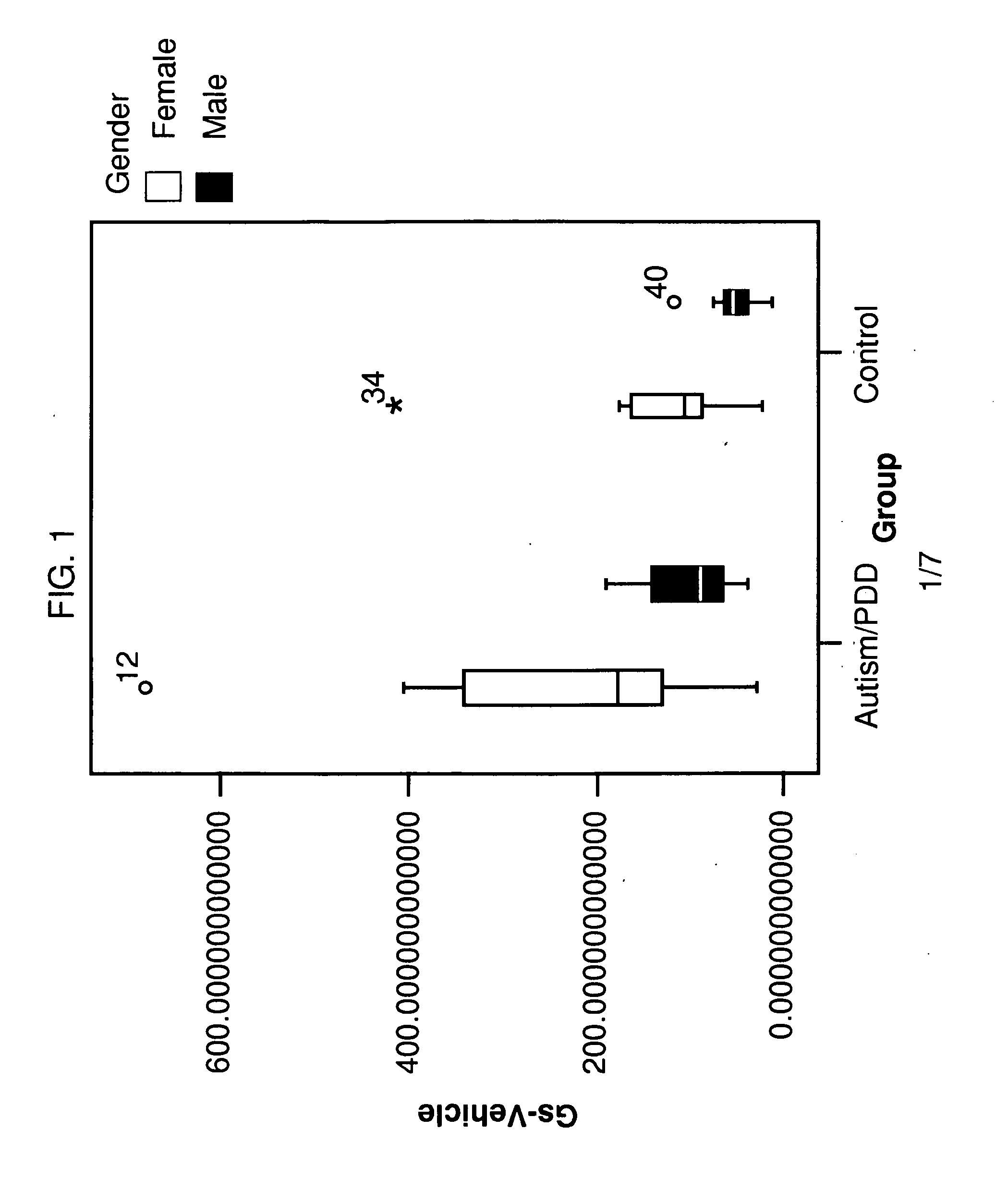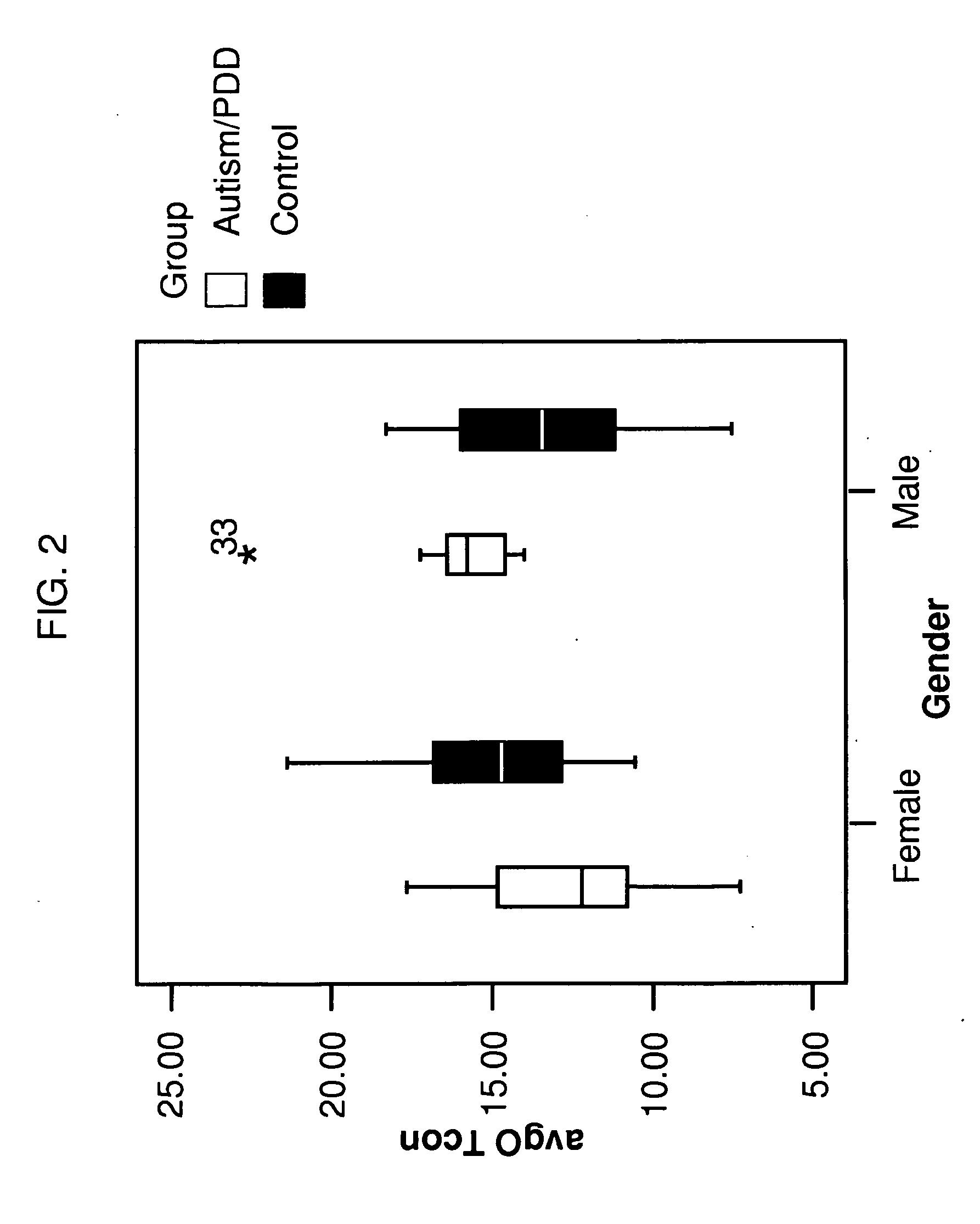Methods and compositions for altering behavior associated with autism spectrum disorder
a technology for autism spectrum disorder and behavior modification, applied in the field of methods and compositions for altering behavior associated with autism spectrum disorder, can solve the problems that the malfunction of g-protein signaling has not received much attention, and achieve the effects of reducing repetitive behavior, reducing scores, and reducing compulsive behavior and/or ritualistic behavior
- Summary
- Abstract
- Description
- Claims
- Application Information
AI Technical Summary
Benefits of technology
Problems solved by technology
Method used
Image
Examples
example 1
[0033]This example determined whether autistic children displayed abnormalities in G-protein expression and function and whether expression and function of stimulatory G-proteins in the peripheral blood mononuclear cells (PMBCs) in females was greater than in males.
Materials and Methods
[0034]Twelve (12) boys and twelve (12) girls with autism spectrum disorder (ASD), as well as 24 typically developing children (12 boys, 12 girls) to be used as controls were selected. All children were ages 4 or 5 years.
[0035]All children diagnosed with ASD were required to have either Autistic Disorder or PDD-NOS as determined by cut-off criteria on the Autism Diagnostic Observation Schedule—Generic (ADOS) and Autism Diagnostic Interview (ADI), and were also required to meet Diagnostic Statistical Manual, Fourth Edition (DSM-IV-TR) criteria as judged by 3 members of an experienced autism team. Ten boys had Autistic Disorder and 2 had PDD-NOS. Eleven girls had Autistic Disorder and 1 had PDD-NOS. Chil...
example 2
[0052]This example determined whether prepubertal children with autism exhibited altered levels of OT compared to unaffected sex-matched controls. This example also determined if there were sex differences in OT levels and if OT levels correlated with measures of social impairment or motor stereotypy.
Materials and Methods
[0053]All 48 children had blood drawn for plasma oxytocin (OT) levels. Determination of OT was performed using a 96-well plate commercial OT enzyme-linked immunosorbent assay (ELISA) kit. Samples were run in duplicate and repeated in two separate experiments when plasma volume was sufficient (42 / 48).
[0054]Based on the paper by Modahl et al (1998)', it was hypothesized that OT levels would be lower in children with ASD as compared to controls and that OT levels would correlate with deficits in social impairment (social recognition) and motor stereotypy. It was also proposed that there might be sex differences in OT levels.
[0055]Plasma OT levels in children with ASD a...
example 3
[0074]This example determined whether there were differences in immune activation and B and T lymphocyte function in autistic children compared to controls, and if sex differences in responsiveness to OT correlate with sex differences in lymphocyte function and cytokine levels.
[0075]High levels of neopterin indicate monocyte / macrophage activation, as well as activation of T-cells and cell-mediated immunity. High blood monocyte counts and high neopterin levels were previously reported in a sample of autistic children2. These studies were repeated. TNF-alpha and IL-6 levels, both of which have been reported to be increased in autism3,4 were also investigated. Eligibility criteria were fairly strict, and children with severe chronic medical problems and children on medications were not included. There were no significant differences between groups in numbers of children with allergy, chronic ear infection, or both compared to children with no medical problems (Fisher's exact test p=0.3...
PUM
| Property | Measurement | Unit |
|---|---|---|
| Fraction | aaaaa | aaaaa |
| Time | aaaaa | aaaaa |
| Time | aaaaa | aaaaa |
Abstract
Description
Claims
Application Information
 Login to View More
Login to View More - R&D
- Intellectual Property
- Life Sciences
- Materials
- Tech Scout
- Unparalleled Data Quality
- Higher Quality Content
- 60% Fewer Hallucinations
Browse by: Latest US Patents, China's latest patents, Technical Efficacy Thesaurus, Application Domain, Technology Topic, Popular Technical Reports.
© 2025 PatSnap. All rights reserved.Legal|Privacy policy|Modern Slavery Act Transparency Statement|Sitemap|About US| Contact US: help@patsnap.com



